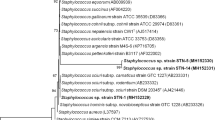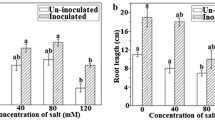Abstract
This investigation was carried out for evaluation of indole-3-acetic acid production by bacteria under salinity and salinity–sodicity stress. A total of 298 bacteria were isolated from soils with different levels of electrical conductivity and sodium adsorption ratio. Then, ability of indole-3-acetic acid production under salinity, salinity–sodicity and l-tryptophan concentrations was analyzed. The results indicated that the ability of growth and indole-3-acetic acid production among bacteria was significantly affected by salinity, salinity–sodicity and l-tryptophan concentration. The one of the bacterial species, Arthrobacter siccitolerans, that were isolated from saline–sodic soils can adjust its indole-3-acetic acid production to different levels of salinity and salinity–sodicity stress conditions. Also, its l-TRP use efficiency under salinity–sodicity stress was 5.01% and reported as the most efficient bacterium. Seed inoculation of A. siccitolerans enhanced wheat aerial and root dry matter under salinity–sodicity stress with respect to control by 10.03 and 15.17%, respectively. The study indicates the different effects of salinity–sodicity on indole-3-acetic acid indole-3-acetic acid production and the potential of A. siccitolerans for production of indole-3-acetic acid and enhancing growth of wheat under salinity and salinity–sodicity stress.


Similar content being viewed by others
References
Ahmad F, Ahmad I, Saghir KM (2005) Indole acetic acid production by the indigenous isolates of Azotobacter and Pseudomonas fluorescent in the presence and absence of tryptophan. Turk J Biol 29:29–34
Alqarawi AA, Abd Allah EF, Hashem A, Al Huqail A, Asma Abdulaziz A, Al Sahli AA (2014) Impact of abiotic salt stress on some metabolic activities of Ephedra alata Decne. J Food Agric Environ 12:620–625
Bui EN (2013) Soil salinity, a neglected factor in plant ecology and biogeography. J Arid Environ 92:14–25
Dauphin L, Moser A, Bowen MD (2009) Evaluation of five commercial nucleic acid extraction kits for their ability to inactivate Bacillus anthracis spores and comparison of DNA yields from spores and spiked environmental samples. J Microbiol Methods 76:30–37
De Salamone IEG, Hynes RK, Nelson RM (2001) Cytokinin production by plant growth promoting rhizobacteria and selected mutants. Can J Microb 47:404–411
Dilfuza E (2011) Indole-acetic acid production by root associated bacteria and its role in plant growth and development. In: Keller AH, Fallon MD (eds) Auxins, structure, biosynthesis and functions. Nova Science Publishers Inc, New York
Egamberdiyeva D, Kamilova F, Validov S, Gafurova L, Kucharova Z, Lugtenberg B (2008) High incidence of plant growth-stimulating bacteria associated with the rhizosphere of wheat growth in saline soils. Biol Fertil Soil 45:561–573
Food and Agriculture Organization (FAO) (2002) World agriculture, towards 2015–2030. Summary report. FAO Information Division, Rome. ISBN 92-5-104761-8
Ghosh S, Basu PS (2006) Production and metabolism of indole acetic acid in roots and root nodules of Phaseolus mungo. Microbiol Res 161:362–366
Hafeez FY, Safdar ME, Chaudhry AU, Malik KA (2004) Rhizobial inoculation improves seedling emergence, nutrient uptake and growth of cotton. Aust J Exp Agric 44:617–622
Iqbal M, Ashraf M (2010) Gibberellic acid mediated induction of salt tolerance in wheat plants, growth, ionic partitioning, photosynthesis, yield and hormonal homeostasis. Environ Exp Bot 86:76–85
Javid MG, Sorooshzadeh A, Moradi F, Sanavy SA, Allahdadi I (2011) The role of phytohormones in alleviating salt stress in crop plants. Aust J Crop Sci 5:726–734
Kazan K, Manners JM (2009) Linking development to defense, auxin in plant pathogen interactions. Trend Plant Sci 14:373–382
Liu W, Li RJ, Han TT, Cai W, Fu ZW, Lu YT (2015) Salt stress reduces root meristem size by nitric oxide-mediated modulation of auxin accumulation and signaling in Arabidopsis. Plant Physiol 168:343–356
Mangang JS, Deaker R, Rogers G (2015) Early seedling growth response of lettuce, tomato and cucumber to Azospirillum brasilense inoculated by soaking and drenching. Hort Sci 42:37–46
Meesungnoen O, Nakbanpote W, Thiwthong R, Tummanu K (2012) Zinc and cadmium resistance mechanism of Pseudomonas aeruginosa PDMZnCd, 2003. Res J Biol Sci 7:4–13
Mohite B (2013) Isolation and characterization of indole acetic acid (IAA) producing bacteria from rhizosphere soil and its effect on plant growth. J Soil Sci Plant Nutr 13:638–649
Page AL, Miller RH, Keeney DR (1982) Methods of soil analysis, 2nd edn. American Society of Agronomy, Madison
Parmeela S, Johri BN (2004) Phylogenetic analysis of bacterial endophytes showing antagonism against Rhizoctonia solani. Curr Sci 87:687–692
Patten CL, Glick BR (2002) Role of pseudomonas putida indoleacetic acid in development of host plant root system. Appl Environ Microb 68:3795–3801
Paul D, Lade H (2014) Plant-growth-promoting rhizobacteria to improve crop growth in saline soils: a review. Agron Sustain Dev 34:737–752
Ramadoss D, Lakkineni VK, Bose P, Ali S, Annapurna K (2013) Mitigation of salt stress in wheat seedlings by halotolerant bacteria isolated from saline habitats. Springer Plus 2:1–7
Siddikee MA, Sundaram S, Chandrasekaran M, Kim K, Selvakumar G, Sa T (2015) Halotolerant bacteria with ACC deaminase activity alleviate salt stress effect in canola seed germination. J Korean Soc Appl Biol Chem 58:237–241
Sparks DL (1996) Methods of soil analysis Part 3—chemical methods SSSA book series no. 5. SSSA and ASA, Madison
Swain MR, Naskar SK, Ray RC (2007) Indole 3-acetic acid production and effect on sprouting of yam (Dioscorea rotundata L) Minisetts by Bacillus subtilis Isolated from culturable cowdung microflora. Pol J Microb 56:103–110
Takahashi S, Tomita J, Nishioka K, Hisada T, Nishijima M (2014) Development of a prokaryotic universal primer for simultaneous analysis of bacteria and archaea using next-generation sequencing. PLoS ONE 9:13–24
Tripathi S, Kumari S, Chakraborty A, Gupta A, Chakrabarti K, Bandyapadhyay BK (2006) Microbial biomass and its activities in salt-affected coastal soils. Biol Fertil Soils 42:273–277
Vestergard M, Bjornlund L, Henry F, Ronn R (2007) Decreasing prevalence of rhizosphere IAA producing and seedling root growth promoting bacteria with barley development irrespective of protozoan grazing regime. Plant Soil 295:115–125
Villareal SQ, Hernandez NZ, Romero IL, Lazcano EA, Dorantes AR (2012) Assessment of plant growth promotion by rhizobacteria supplied with tryptophan as phytohormone production elicitoron Axonopus affiis. Agric Sci Res J 2:574–580
Wang QF, Li W, Liu YL, Cao H, Li Z, Guo GQ (2007) Bacillus qingdaonensis sp. nov, a moderately haloalkaliphilic bacterium isolated from a crude sea-salt sample collected near Qingdao in eastern China. Int J Syst Evol Microb 57:1143–1147
Weisskopf L, Fromin N, Tomasi N, Aragno M, Martinoia E (2005) Secretion activity of white lupin’s cluster roots influences bacterial abundance, function and community structure. Plant Soil 268:181–194
Willey JM, Sherwood LM, Woolverton CJ (2009) Prescott’s principles of microbiology. McGraw-Hill, New York
Acknowledgements
The authors thank manager of Department of Soil Science, Tehran University, Tehran, Iran, for providing the necessary facilities for this study.
Author information
Authors and Affiliations
Corresponding author
Additional information
Editorial responsibility: Xu Han.
Rights and permissions
About this article
Cite this article
Soleimani, R., Alikhani, H.A., Towfighi, H. et al. Isolated bacteria from saline–sodic soils alter the response of wheat under high adsorbed sodium and salt stress. Int. J. Environ. Sci. Technol. 14, 143–150 (2017). https://doi.org/10.1007/s13762-016-1153-6
Received:
Revised:
Accepted:
Published:
Issue Date:
DOI: https://doi.org/10.1007/s13762-016-1153-6




